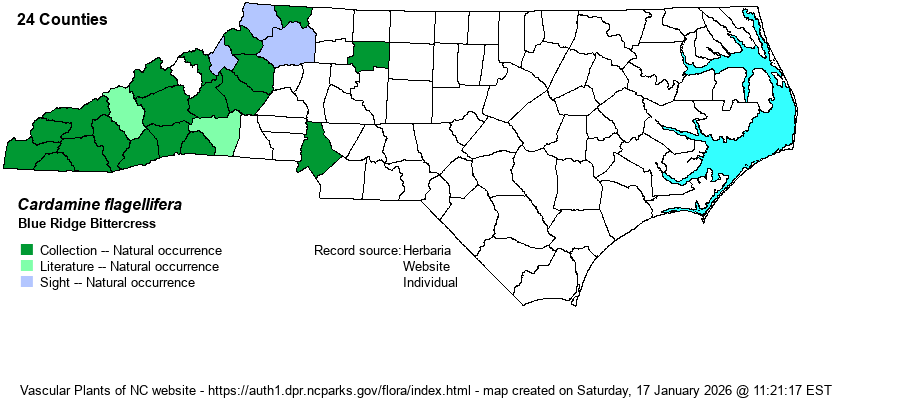| Author | O.E. Schulz | |
| Distribution | Essentially throughout the Mountains, and sparingly into the central Piedmont. Note that older references had this species lumped into C. clematitis, as this species was not even described until 1974. Some county records on the map below could refer to C. clematitis, but it is believed that C. flagellifera occurs in all mountain counties.
This is a Southern Appalachian species, ranging from southern WV and southwestern VA to northwestern SC and northern GA. | |
| Abundance | Uncommon to infrequent in the Mountains, at low to middle elevations, essentially below 4000 feet in elevation; very rare into the Piedmont. The NCNHP has placed varieties in NC on the Watch List, as of late 2022. | |
| Habitat | "In seepages, on streambanks, and in moist cove or bottomland forests, mainly at moderate to low elevations" (Weakley 2018). The very similar C. clematitis grows in seepages at higher elevations. | |
| Phenology | Blooms from March to May, and fruits from June to July. | |
| Identification | Both this species and C. clematitis are quite similar in overall appearance. Each is somewhat leaning to erect, to about 7-8 inches tall. Each has small basal leaves. The several alternate stem leaves are strongly pinnately divided into 3-5 segments, one terminal and 1-2 pairs of lateral leaflets; each leaflet is a bit oddly lobed and shaped, generally somewhat rounded and about 1-inch across and long at most. The flower cluster at the end of the stem is like others in the genus, with a few 4-petaled white flowers blooming at a single time, each one being about 1/2-inch across. These two species can easily be told from others by the odd stem leaves separated into 3-5 rounded leaflets. This species can be separated from C. clematitis by: 1) the stem is pubescent at the base, as opposed to smooth at the base in the other; 2) the lower stem leaflets are purple below, whereas the other has green leaflets below; 3) the petioles are not auriculate (eared) at the base, but are auriculate in the other; 4) the leaves have 3-5 leaflets, versus mostly just 3 leaflets in the other; and 5) the siliques (capsules) are 10-25 mm (about 2/3-inch on average) long, versus 22-40 mm (about 1.3 inches on average) long, based on characters in Weakley (2018). Thus, look for leaflets that are purple below, and a pubescent stem at the base, for this low and middle elevation species; if fruit are present, this one has them shorter than 1-inch long. | |
| Taxonomic Comments | As mentioned above, many of the older C. clematitis records had to be re-distributed between that species and C. flagillifera. Not only that, but Weakley (2018) shows two varieties of C. flagillifera in the state -- the nominate one and var. hugeri. See his reference for more information about the distinctions of these. The website range maps for these two varieties have to remain incomplete owing to most specimen labels not listing varieties.
| |
| Other Common Name(s) | None | |
| State Rank | S3 | |
| Global Rank | G3 | |
| State Status | | |
| US Status | | |
| USACE-agcp | | |
| USACE-emp | FACU link |

